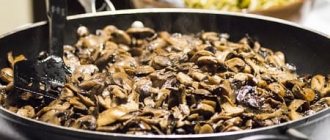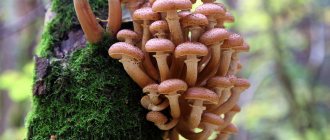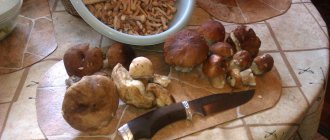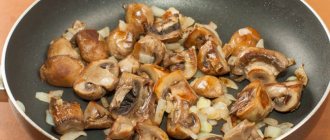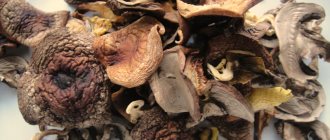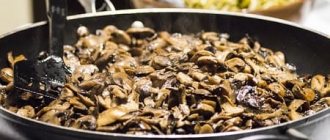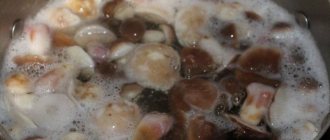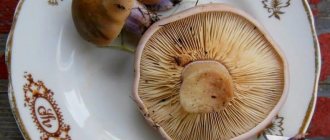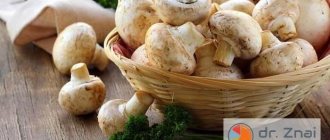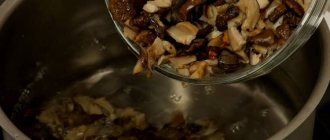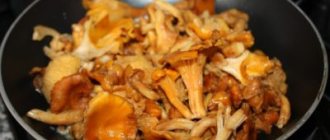Saffron milk caps are unique. Can't be confused with other mushrooms. They do not have inedible “doubles”. They represent the lamellar group, but in terms of nutritional value they belong to edible mushrooms of the first category, and in terms of nutritional properties they are not inferior to chicken eggs and beef.
The question of the need for pre-boiling is controversial. Some recipes do not provide for this procedure at all.
If you collected them yourself and know exactly the history of mushrooms, then you can do without cooking. Young mushrooms, which are collected in ecologically clean areas, can be used by leaving them in a slightly salted state for several hours in a cool place.
If the mushrooms were bought at the market from strangers, and you are unsure of their quality or where they were collected, then it is better to play it safe and boil them before “conjuring” them further and creating culinary masterpieces.
The cooking time for saffron milk caps depends on what will happen to them next: they will be pickled, salted, fried, put in the freezer or in a salad.
The standard boiling time specified by experts is 15–25 minutes. Do you doubt the quality of mushrooms? Increase cooking time by 5 minutes.
How to cook saffron milk caps
You will need: saffron milk caps, water for cooking
1. Clean the saffron milk caps brought from the forest from soil, dirt and other forest debris. 2. Check each mushroom for worms by cutting in half; cut off the wormy parts. 3. Pour cold water into a bowl, pan or basin and carefully move the mushrooms there so as not to break them. 4. Rinse the mushrooms thoroughly so that small particles of debris are separated from the mushrooms. 5. Drain this water and add another. 6. Put on gas and cook for 15-20 minutes after the water boils.
Video
We offer you a few more recipes with different methods of pickling saffron milk caps in the following videos:
About the author:
Emma Murga Graduated from MGRI named after. Ordzhonikidze. My main specialty is a mining geophysicist, which means a person with an analytical mind and varied interests. I have my own house in the village (accordingly, I have experience in vegetable gardening, horticulture, mushroom growing, as well as fiddling with domestic animals and poultry). Freelancer, a perfectionist and a “borer” regarding his duties. Handmade lover, creator of exclusive jewelry made from stones and beads. A passionate admirer of the written word and a reverent observer of everything that lives and breathes.
Found a mistake? Select the text with the mouse and click:
Ctrl + Enter
Did you know that: Humus is rotted manure or bird droppings. It is prepared like this: the manure is piled up in a heap or pile, layered with sawdust, peat and garden soil. The pile is covered with film to stabilize temperature and humidity (this is necessary to increase the activity of microorganisms). The fertilizer “ripens” within 2-5 years, depending on external conditions and the composition of the feedstock. The output is a loose, homogeneous mass with a pleasant smell of fresh earth.
Compost is rotted organic remains of various origins. How to do it? They put everything in a heap, hole or large box: kitchen scraps, tops of garden crops, weeds cut before flowering, thin twigs. All this is layered with phosphate rock, sometimes straw, earth or peat. (Some summer residents add special composting accelerators.) Cover with film. During the process of overheating, the pile is periodically turned or pierced to bring in fresh air. Typically, compost “ripens” for 2 years, but with modern additives it can be ready in one summer season.
In Australia, scientists have begun experiments in cloning several varieties of grapes grown in cold regions. Climate warming, which is predicted for the next 50 years, will lead to their disappearance. Australian varieties have excellent characteristics for winemaking and are not susceptible to diseases common in Europe and America.
Both humus and compost are rightfully the basis of organic farming. Their presence in the soil significantly increases the yield and improves the taste of vegetables and fruits. They are very similar in properties and appearance, but they should not be confused. Humus is rotted manure or bird droppings. Compost is rotted organic remains of various origins (spoiled food from the kitchen, tops, weeds, thin twigs). Humus is considered a higher quality fertilizer; compost is more accessible.
Natural toxins are found in many plants; Those grown in gardens and vegetable gardens are no exception. Thus, the seeds of apples, apricots, and peaches contain hydrocyanic acid, and the tops and peels of unripe nightshades (potatoes, eggplants, tomatoes) contain solanine. But do not be afraid: their number is too small.
The homeland of pepper is America, but the main breeding work on developing sweet varieties was carried out, in particular, by Ferenc Horvath (Hungary) in the 20s. XX century in Europe, mainly in the Balkans. Pepper came to Russia from Bulgaria, which is why it received its usual name - “Bulgarian”.
Tomatoes have no natural protection against late blight. If late blight attacks, any tomatoes (and potatoes too) die, no matter what is said in the description of the varieties (“variety resistant to late blight” is just a marketing ploy).
In little Denmark, any piece of land is a very expensive pleasure. Therefore, local gardeners have adapted to growing fresh vegetables in buckets, large bags, and foam boxes filled with a special earthen mixture. Such agrotechnical methods make it possible to obtain a harvest even at home.
One of the most convenient methods for preparing a harvest of vegetables, fruits and berries is freezing. Some believe that freezing causes the nutritional and health benefits of plant foods to be lost. As a result of the research, scientists have found that there is practically no decrease in nutritional value when frozen.
Recipe for saffron milk caps in sour cream
Products
Ryzhiki - 500 grams, Sour cream - 150 grams, Onion - 1 head, White crackers - 3 heaped tablespoons, Dill, salt and pepper - to taste.
How to fry
1. Peel the saffron milk mushrooms, rinse, cook in salted water for about 10 minutes, dry and chop. 2. Place the mushroom pieces in a hot frying pan, sprinkled with oil, pepper, add fried onions, fry over medium heat for 5-7 minutes until golden brown. 3. Add sour cream to the saffron milk caps, sprinkle breadcrumbs on top, stir and turn off the heat. 4. Before serving, sprinkle with dill.
Nuances of processing and preparation
When starting to prepare pickled saffron milk caps, you should pay attention to several nuances:
- Saffron milk caps are one of the cleanest mushrooms. They do not require thorough rinsing. It is enough to clean the mushroom from sand and debris adhering to the cap.
- If the mushrooms still need to be washed, they are soaked for half an hour in cold water, after which they are thoroughly washed under running water.
- Before pickling, mushrooms need to be boiled in salted water, since, like honey mushrooms, saffron milk caps secrete mucus. Cooking before canning and pickling significantly reduces their stickiness.
- After blanching, saffron milk caps can be canned, salted and pickled.
How to cook saffron milk caps for pickling
Products
Saffron milk caps - 1 kilogram Salt - 1.5 tablespoons Vinegar - 0.5 teaspoons Water - 100 milliliters Bay leaf - 2 pieces Pepper (black peas) - 10-15 peas Garlic - 3 cloves Vegetable oil - 200 grams Fresh dill - one sprig (you can take dry herbs)
How to cook pickled saffron milk mushrooms
1. Place all ingredients (except oil) and peeled, washed mushrooms in a saucepan in layers. 2. Place the pan with food on low heat. 3. After the water boils, boil for another thirty minutes. 4. When the mushrooms are boiled, they need to be shaken periodically, but should not be stirred with a spoon so that they do not break or crumble. In this case, they will lose their appearance. 5. Place the still hot mushrooms along with the brine into sterilized jars. 6. After 20-30 minutes, add brine and add a little vegetable oil on top. 7. Roll up the jars with iron lids. The product can be stored in jars for a whole year without refrigeration.
The best autumn mushrooms
It is in the autumn that you can collect a whole basket of saffron milk caps. You can pickle them, freeze them, or dry them. And from a small amount of fresh mushrooms we suggest preparing a delicious treat - saffron milk caps stewed in sour cream. No one can resist such aromatic yummy, you just have to try it.
Ingredients:
- fresh saffron milk caps – 500-600 g;
- ground allspice - one pinch;
- salt;
- laurel leaves - one or two pieces;
- filtered water;
- sour cream with a fat concentration of 20% - 120 ml;
- onion - one head;
- fresh dill - several sprigs;
- refined vegetable oil – 100 ml.
Preparation:
- First, let's sort out the saffron milk caps. We immediately discard spoiled or rotten fruits. We thoroughly clean the rest and rinse thoroughly.
- Immediately prepare the remaining ingredients. By the way, saffron milk caps will acquire a completely different taste if they are fried in butter.
- After processing, transfer the saffron milk caps into a saucepan and fill with filtered water.
- Bring the liquid to a boil, remove the foam with a slotted spoon.
- Reduce heat and set aside for 20 minutes.
- After the allotted time has passed, transfer the boiled saffron milk caps to a colander. Rinse them thoroughly again and leave them for a while to drain excess moisture.
- Then cut the mushrooms into strips.
- Chop the peeled onion into small cubes.
- Heat refined vegetable or butter in a frying pan.
- First, lay out the chopped onion and saute it until it becomes soft and acquires a light golden hue.
- Then add chopped boiled saffron milk caps. Mix everything well and continue frying for another 3-5 minutes.
- At the very end, we season the mushrooms with salt, ground allspice and sour cream at room temperature.
- Stir thoroughly, simmer for just a couple of minutes and set aside from the stove.
- The dish turns out aromatic. It can be added to a side dish or served as a stand-alone treat.
How to cook saffron milk caps for pickling
Products
Saffron milk caps - 1 kilogram Garlic - 2 cloves Dill - half a bunch Salt - 2 tablespoons Black peppercorns - 10 peas Bay leaves - 2 leaves
How to pickle saffron milk caps
1. Peel, wash the saffron milk caps, place in a saucepan, add cold water and cook for 5 minutes after boiling, skimming off the foam. 2. Place the boiled mushrooms in a colander and let the water drain. 3. Place them in a bowl, sprinkling each mushroom layer with salt, spices and garlic petals. 4. Cover the filled jar with a cloth, put a weight on top, put it in the refrigerator, and salt it at a temperature of 0 to 7 degrees. 5. The mushrooms will be ready in a month and a half. The color of the brine of properly salted mushrooms is brown. 6. Place the workpiece in jars and roll it up, store it for winter in a cool, dark place.
Dry salting method
It is considered the best, since the mushroom product is of the highest quality. This method is used to salt mostly saffron milk caps and the best types of russula, that is, mushrooms that do not have a bitter taste and, therefore, do not require pre-processing (soaking, blanching and boiling). In addition, these are juicy mushrooms, and therefore they themselves will provide enough juice for the brine when salted. You can also salt milkweed.
It is better not to wash the saffron milk caps before dry salting, but only wipe them thoroughly with a damp cloth. You can salt in barrels, enamel buckets, pans, porcelain or glass jars. Simply salting in a metal container is unacceptable due to its oxidation. In all cases, dishes should be thoroughly washed or even steamed with blackcurrant, nettle leaves or juniper branches. A little salt is poured into the bottom, the mushrooms are laid in a layer 5-6 cm thick with the caps facing down, then each layer is sprinkled with salt at the rate of 40 g for saffron milk caps per 1 kg of fresh mushrooms, for other types of mushrooms 50-60 g (this is for mass harvesting, and for homemade, you can take less, about 30 g). The top of the mushrooms is covered with a clean (boiled) cloth, then with a wooden circle that fits freely into the container, on which a weight is placed.
After a few days, the pickled mushrooms will thicken, release juice and gradually settle. As the dishes settle, they should be replenished with new portions of mushrooms until they are filled to the top. Fresh mushrooms are sprinkled with salt in the same way as when adding mushrooms for the first time. However, it must be taken into account that the settling of mushrooms is slow, and replenishment may be delayed due to the lack of new mushroom collections. In this case, you can fill the bowl with boiled chilled water to the top at the rate of 1 liter per 10 kg of mushrooms. After this, the barrel or other container must be tightly closed. This way the prepared mushrooms will not spoil.
How to cook saffron milk caps for salad
Products
Chicken eggs - 3 pieces Chicken breast fillet - 350 grams White bread - 1-2 pieces Mayonnaise - 200-250 grams Vegetable oil - 40 grams (for frying) Pickled saffron milk caps - 200 - 300 grams
How to prepare a salad with saffron milk caps
1. Boil chicken breast fillet in salted water and cut into 0.5-0.8 centimeter cubes. 2. Hard-boil eggs for 10 minutes. 3. Fry chicken meat in a frying pan, pre-greased with vegetable oil. 4. Cut the white bread into cubes, 1 centimeter sides. 5. In the same frying pan, fry pieces of white bread until golden brown. 6. Peel the eggs and finely chop them by hand (you can use a special egg cutter). 7. Mix saffron milk caps, fillet, white bread croutons and eggs in a salad bowl. 8. Add mayonnaise to the salad with saffron milk caps and mix well.
Rules for storing workpieces
How do you pickle saffron milk caps?
ColdHot
Pickled saffron milk caps are stored at a temperature no higher than + 8 degrees. The shelf life of the product under metal covers is 12 – 24 months. After opening the can - no more than 14 days.
Mushrooms prepared using the open method can be stored for 3 to 6 months. The brine must completely cover the product, otherwise mold will form on the surface and the product will deteriorate.
During storage, the blanks should not be exposed to sunlight, so you cannot keep the jars on the balcony or loggia. Mushrooms with signs of mold or those that have turned black during storage should not be consumed.
Pickled saffron milk caps are a tasty and healthy product. However, they should not be eaten by those suffering from pancreatitis, cholecystitis and low stomach acidity.
Benefits for the body
Ryzhiki are very famous and widespread mushrooms. They are valued not only for their original taste, but also for their powerful beneficial properties:
- they owe their beautiful color to the high content of beta-carotene, which in the body is converted into retinol (vitamin A), the benefits of which are widely known;
- they contain a natural antibiotic - lactarioviolin, which inhibits the growth of most harmful bacteria. Thanks to him, saffron milk caps are used in the treatment of many diseases and even tuberculosis;
- they are rich in protein, in terms of the number of valuable amino acids they are even compared to meat, which is why pickled saffron milk caps are especially valued by vegans and vegetarians;
- have a good effect on the condition of the skin, nails, and hair, because they contain mineral salts of potassium, sodium, magnesium, phosphorus, and calcium.
After heat treatment, the composition of amino acids in saffron milk caps will not change, which is why they are so useful when pickled and we try to prepare more of them for the winter.
